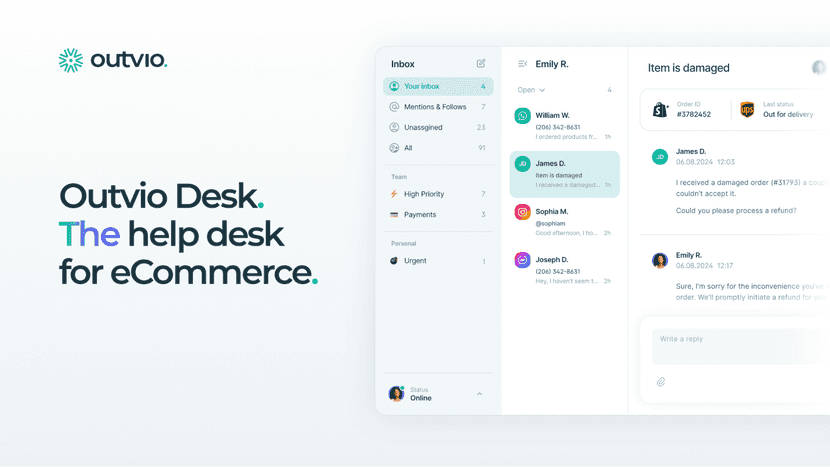Customer service in eCommerce is the set of strategies and tools that an online shop uses to manage interactions with the user before, during, and after the purchase. It aims to eliminate friction, minimize operational costs, and improve customer satisfaction in order to increase customer loyalty.
However, when it comes to providing good service for eCommerce, many online shops fail without even knowing it. Did you know that 80% of companies believe they have excellent customer service, but only 8% of their users agree? Despite this, 96% of consumers consider customer service to be a vital factor for repeat purchases.
Why do many eCommerce businesses fail with customer service?
After analyzing thousands of online shops over the last few years, we at Outvio have observed that eCommerce tends to approach customer service as business as usual. In other words, the support process stops once the purchase has been completed, forgetting a really critical stage: the delivery of the products.
Why is the delivery phase important in the customer experience? It is precisely here that a large number of customer problems occur. We are talking about delays, losses, damaged products, absence of buyers during delivery, poor management of returns, etc.
To ensure good customer service, eCommerce must do everything possible to improve this phase, providing resources so that the agents or the customer can solve the problems that arise in the most efficient way possible.
In this guide, we will explain how to develop professional customer service for eCommerce businesses. We'll cover the crucial aspects that make a difference. Here are some key ideas briefly outlined:
- The level of support service will depend on the technology and suppliers integrated into your order management system
- Customer service in eCommerce is cross-cutting: it affects not only your support department but also logistics agents or even marketing and sales
- Delays, damage, or loss of products during shipping are one of the main sources of complaints and frustrations
- Proper order preparation will eliminate many of the problems mentioned in the previous point
- The main reason a customer contacts a business is to ask where their order is (known as WISMO)
- Returns directly affect your customer experience. Good returns management can turn a dissatisfied buyer into a loyal customer
- In eCommerce, the most important emails or messages are follow-ups: those that we send to inform shoppers about their orders
- Customers prefer to solve problems themselves through self-managed portals. We recommend minimizing contact with agents as much as possible
- You can turn customer service into another revenue channel through personalized product recommendations and brand recall actions
Types of customer service: Which one does your eCommerce need?

This question is vital. There are many ways to approach customer service; it all depends on the size of your eCommerce and your technology stack (the number of applications you have integrated).
- Basic level: We only centralize the channels so that agents and buyers can communicate seamlessly. You will be able to track inquiries, add chat, and automate certain responses
- Intermediate level: Customer service is linked to the order management system. Agents have access to purchase data, such as delivery address or product SKU, so they can automate much more effective actions for customer satisfaction
- Advanced level: Customer service is fully integrated with the order management system and transport companies. Customer service agents have full control over orders. They can make any changes to the order and communicate them to the carrier to ensure that the problem is resolved as quickly as possible. It also gives buyers the option to manage their purchase or return themselves, improving the customer experience and dramatically increasing internal business productivity
7 Key Benefits of Improving Customer Service in eCommerce
Improve your business image
Exceptional customer service creates a positive user experience, which translates into a better perception of your brand. By ensuring consistently good service, your eCommerce is likely to gain a strong reputation within your industry, setting you apart from your competitors.
Attract more customers
Around 60% of customers say they would abandon their business relationship with a brand after a bad interaction. Improving customer service will have the opposite effect: most of them will be delighted with your business and will seek repeat business in the future. You will gain loyal and much more profitable customers.
Increase sales and revenue
89% of consumers say they would make additional purchases after receiving satisfactory interactions from a brand. Additionally, 68% say they are willing to make higher-value purchases from eCommerce platforms that resolve their questions and problems quickly and effectively.
Reduce logistical and management costs
Inefficient support departments incur additional costs due to human error and management problems. By automating the service, you will reduce direct recruitment and transport logistics costs. Additionally, your employees will be able to perform their work using fewer corporate resources.
Employees productivity
Automation and omnichannel management typically generate a very positive work environment for employees. Additionally, training and technology will improve their response times, allowing them to devote their time to solving queries of greater value to the business or applying up-selling techniques.
Decrease number of returns
A good portion of unresolved problems in eCommerce leads to return requests. Therefore, by investing in agile and quality processes, you will be able to resolve your customers' queries, minimizing the cost of returns management.
User advocacy
Users tend to recommend online stores with which they have good experiences. Specifically, 72% of customers said they would speak positively of an eCommerce with good customer service, which is a fundamental improvement for attracting new traffic.
Related article
What do customers expect from support services? Trends for 2024
The reason you want to improve your support service is to retain customers and increase revenue. It is important to meet the expectations of your users.
It's no longer enough to offer quality products at competitive prices; consumers now demand personalized, proactive, and channel-agnostic support.
Your customers should be able to access support at any time and through any channel they prefer, whether it's chat, email, telephone, or social media. Similarly, response time should be short and concise, always focused on solving the user's problem. Did you know that 67% of customer churn can be avoided if brands solve customer problems at the first contact?
72% of consumers say they highly value free shipping and returns. On the other hand, responses must be individualized and have a human touch, avoiding robotic interactions. Additionally, 75% of customers expect interactions with agents. Self-service portals are also gaining momentum: according to Statista, 48% of businesses that use them substantially improve their customer service.
In summary, what should eCommerce customer service look like in 2024?
- Accessible
- Agile
- Helpful
- Human
- Personalized
- Efficient
- Self-service
What good customer service looks like: effective practices and strategies for eCommerce

1. Unify contact channels for seamless communication
66% of consumers use at least three different channels to contact customer service. It is essential that you unify these channels (usually those where you sell and your social media) into a single support tool.
I recommend you always opt for an omni-channel approach: your customers should be able to start an interaction in one channel and continue it in another, without losing the thread of the conversation or the relevant information. For this, you will need to use omnichannel support software specialized in eCommerce.
Related article
2. Establish clear shipping and return policies
Shipping and return policies play a dual role. On the one hand, they define the level of flexibility of your customer service. If you offer few possibilities, more customers will contact you for less restrictive shipping and returns.
On the other hand, both policies influence users' purchasing decisions. Offering clear and transparent shipping options, such as fast or free shipping, can make a difference and improve customer confidence. We recommend adding them in a visible place on your website.
3. Always meet promised delivery times
Transportation is a crucial stage for eCommerce customers. 95% of users expect problems during delivery to be solved en route, without affecting the promised delivery time, which is one of the most common areas of failure. This is one of the most common areas of failure. How can we resolve problems with a shipment that occur during transport? There are several ways:
- Connect the eCommerce customer service software with the carrier (service level 3): the agent will be able to find out what the problem is and communicate with the carrier immediately. For example, errors in the delivery address.
- Integrate a tracking portal so that customers know where the order is at all times and can contact agents directly to request changes.
- Use Outvio's Incident Suite. The tool identifies and resolves common shipping issues automatically, eliminating agent workload
4. Personalization of responses and channels
As we have already seen, buyers want humanized and personalized communication. To achieve this, it is important that you analyze and understand user behavior. By understanding why they do what they do, it will be easier for you to create responses tailored to their preferences.
You should also personalize your communication channels with your designs and logos to increase brand recall and customer retention (chat, shipping or returns portals, notifications, etc.)
5. Add a customer self-service software
Your customers want to manage their orders themselves. Avoid making them have to contact your shop. Integrate a returns or tracking portal so that users have control over their orders. They will be able to monitor their location, make changes of address, request returns, exchange products for others, etc. In short, they will be the ones to manage all these aspects themselves and not your agents. This will not only improve the support service of your eCommerce but will also save time and work for your employees. Outvio provides such portals.
6. Integrate an eCommerce live chat software
79% of eCommerce companies that use live chats report an increase in sales and customer loyalty. Not only can you answer questions effectively, but you can also exchange files, add logos, promotions, reply bots, and more. If you opt for Outvio's advanced chat, you can synchronize it with your tracking and returns portals, offering your customer a unique and comprehensive management of their own orders.
Related article
7. Send proactive order and return messages
Sending automated order messages is essential to keep your customers informed about the status of their purchases, which contributes to a positive shopping experience. By anticipating their needs, you prevent them from having to contact your company for information.
Remember that order notifications have a much higher open rate than traditional messages. Additionally, you can take advantage of these communications to include promotional banners and turn them into effective sales campaigns.
The most important messages are usually the following:
- Abandoned order reminder
- Confirmation of completed transaction
- In-transit shipment notification
- Notification of shipping incident
- Delivery in progress update
- Confirmation of acceptance of return
8. Create automated responses to common questions
Automated responses are pre-defined templates that can be set up in help desk software to automatically respond to frequently asked questions. This allows agents to save time and effort, and focus on more complex tasks that require personalized attention.
Identify the most common queries by analyzing data from your help desk software and classify them by type. Then develop response templates that are clear, concise and contain relevant information and practical solutions.
9. Correctly check the goods in the packages
Many transport incidents originate directly in the warehouse. A simple mistake on the transport label can lead to delays, losses, or missed deliveries. It is important that your operators are trained to process orders properly, without making mistakes during the fulfillment phase
10. Measure your eCommerce customer service success
To evaluate the success of your eCommerce customer service, it is important to establish and track key performance indicators (KPIs). These indicators help you evaluate real-time effectiveness, identify areas for improvement, and track important metrics such as customer satisfaction and agent interaction time. Typically, the help desk will already provide you with this information; your job is to interpret it to extract valuable insights.
Related article
| Aspect | Strategy | Tip |
|---|---|---|
| Unify contact channels | Implement omni-channel support software specialized in eCommerce | Offer various communication channels: chat, email, phone, social media |
| Establish clear shipping and return policies | Clearly define shipping and return policies on your website | Include information on shipping costs, delivery times, and return process |
| Always meet promised delivery times | Connect customer service software with carriers; integrate tracking portals; use incident resolution tools | Provide real-time tracking updates to customers |
| Personalization of responses and channels | Analyze and understand user behavior for tailored responses; personalize communication channels | Use customer data to personalize interactions and recommendations |
| Add self-service shipping and return portals | Integrate self-manageable returns or tracking portals | Include FAQs and guides for self-service management |
| Integrate live chat for eCommerce | Implement live chat with advanced features; synchronize with tracking and returns portals | Offer chatbots for immediate assistance and FAQs |
| Send proactive order and return messages | Set up automated order messages; include promotional banners | Customize messages based on order status and customer preferences |
| Create automated responses to common questions | Develop response templates in help desk software for frequently asked questions | Ensure responses are clear, concise, and address common concerns |
| Correctly check the goods in the packages | Train operators to process orders properly and avoid mistakes | Implement quality control measures to ensure accuracy |
| Measure your eCommerce customer service success | Establish and track key performance indicators (KPIs); interpret data for insights | Monitor customer feedback and reviews for continuous improvement |
Workflows and automations for eCommerce customer service
An important aspect of any customer service for eCommerce or online shops is automation. If you want to maximize performance, you can use workflow systems and generate a support response algorithm.
If you are not used to help desk systems or don't know exactly what they are, the most important thing is to understand their automation possibilities for eCommerce customer services.
Let's look at the most common options:
1. AI-powered chatbots
Artificial intelligence (AI)-powered chatbots are virtual agents that provide instant responses to customer queries. You simply select an automatic response to a specific word that acts as a trigger.
Example of use: Your customer contacts you to ask where the order he placed a few days ago is. The system is able to recognize the user's intent, providing an instant response and redirecting to the tracking portal. This would be an example of a complete workflow.
2. Dynamic personalization
By analyzing real-time data on customer behavior and preferences, you can automatically tailor the shopping experience and customer service to the specific needs of each customer, increasing the relevance and impact of your interactions.
Example of use: A user connects to request information about an item. The system analyzes which customer they are and what they have previously purchased. This way, in addition to solving their problem, you can recommend alternative products to increase the value of the order.
3. Predictive problem resolution
Systems like Outvio can automatically detect when a customer or carrier encounters an issue with an order. The algorithm identifies early warning signs and takes immediate action to mitigate potential risks.
Example of use: The delivery address is incorrect. The system detects this and contacts the customer directly to provide the carrier with the new address.
4. Automatic allocation of incoming tickets
Automatic allocation of incoming tickets is a process whereby customer service tickets, queries, or requests that come into a company are automatically distributed to the appropriate team members for resolution.
Example of use: A customer contacts to request technical help with the installation of a rather complex product. The system analyzes the query and automatically routes it to an agent specialized enough to solve the problem.
Related article
Common mistakes in customer service and support for eCommerce

Lack of branding
Customer interactions are not leveraged to strengthen brand identity. The solution is to include visual elements (logo, colors) and consistent messaging across all customer service channels to increase brand recall.
Lack of incentives for product switching
The customer is not motivated to change a product for a better one, missing an opportunity to increase sales and satisfaction. The solution is to offer discounts, promotions, or personalized content to encourage product switching.
Failure to take advantage of up-selling
E-commerce does not take advantage of opportunities to increase the average ticket through personalized recommendations. The solution is to implement up-selling strategies, such as recommending complementary or higher-value products in the shopping cart or in shipping notifications
Repeating information when escalating tickets
Customers must repeat information as they move from one agent to another, leading to frustration and wasted time. The solution is to implement an efficient ticket management system that centralizes customer information and enables transparent case tracking.
Lack of scalability
Customer service capacity does not adapt to peak season demand, affecting the shopping experience. The solution is to implement scalable solutions, such as chatbots or self-service tools, to absorb the increase in inquiries at specific times.
Lack of shipment tracking
Not offering shipment tracking creates uncertainty and concern for customers. The solution is to implement a transparent tracking system that allows customers to know the status of their order in real-time.
Ignoring bad reviews
Not responding to negative online reviews damages the company's image and does not allow you to improve your service. The solution is to monitor online reviews and respond to criticism in a professional manner, offering solutions and showing interest in improving the customer experience.
Related article
Managing eCommerce support agents: 4 essential steps
Your customer service team not only acts as the first point of contact between your company and your customers, but also plays a vital role in customer satisfaction and brand reputation.
Step 1 - Create your eCommerce customer support team
Identify the people and roles you need in your support department. It is crucial to cover all the important aspects of your business. For example, if you handle a large amount of returns for your online shop, it may be useful to add a logistics manager specializing in returns or transportation.
Some common roles in eCommerce customer support departments include:
- Call center agent
- Customer service agent
- Multilingual specialist
- Technical or product manager
- Social media response manager
- Transport integration manager
- Logistics manager
Step 2 - Conduct regular training processes
It is essential to ensure that each member of your team is fully trained to manage the technology in their department and is aware of the best practices in customer service. Here are some recommendations:
- Work on the language and tone your agents should use when dealing with customers.
- Train your employees to handle recurring scenarios
- Train your employees to identify the root problem of each query
- Teach them how to interpret help desk metrics
- Create response models to deal with difficult customers
- Design user guides for the technology solutions used in your business.
- Train employees to make upselling recommendations
Step 3 - Prioritize strategic sourcing
This entails effective communication skills, the ability to solve problems quickly and efficiently, as well as expertise in logistics, carrier management, order preparation, returns, or API integrations.
Step 4 - Define ticket routing system
Implement an escalation system to handle more complex problems or difficult situations. This involves assigning the most experienced and skilled agents to solve problems that require a higher level of knowledge or skills.
Related article
Ecommerce customer service software: the need for a holistic approach to reduce costs
Traditional customer service systems often have limitations when it comes to addressing the support operations of eCommerce businesses. Many of these systems only synchronize contact channels and automate certain tasks but are not able to integrate or connect with other service providers. For example, a customer might inquire about an item in their cart or an item that is already on its way. If the agent does not have that information readily available or has to access another platform, the quality of service worsens.
For example, a customer might ask about an item in their basket or one that is already on its way. If the agent does not have that information or has to access another platform, the quality of service worsens. This often prompts eCommerce businesses to integrate different tools into their technological framework, such us help desk systems for eCommerce, returns management software, shipping agregators, tracking systems, etc.
The result? Confusion for the customer, chaos for the agents and an excessive number of tools to synchronize and maintain.
This is where the importance of taking a holistic approach with a tool like Outvio comes into play. Instead of patching together multiple standalone solutions, the system encompasses all aspects of eCommerce customer service. It not only handles inquiries and complaints but also seamlessly coordinates warehouse logistics, order status, and carrier information.
How Outvio improves your eCommerce customer service

Do you want to strengthen your customer relationships and boost sales? Outvio Desk is a solution specifically designed to improve eCommerce customer service. With this software, your agents will have full access to order details and centralize communication to automate problem resolution for both customers and carriers.
Power your online shop with Outvio Desk's unique features:
- Social media integration: Manage customer queries, comments, and direct messages from customers in one place, ensuring fast and consistent responses across all channels.Carrier integration: Allows customers to choose and track the status of their shipments in detail, offering flexibility and control over their purchases
- Response automation: Free your agents from repetitive tasks by automating responses to common queries, streamlining customer service and improving the customer experience
- Assignment rules: Automatically route inquiries to the most appropriate agent, ensuring accurate and efficient support
- Live chat for eCommerce: Provide real-time assistance to customers as they browse your website, increasing conversions and improving customer satisfaction
- Returns Portal: Simplify the product return process for customers, reducing costs and increasing revenue
- Tracking portal: Allow customers to track their orders in real-time, reducing anxiety and improving customer satisfaction
- Integrated order management: Centralize all order-related information to provide efficient and personalized customer service
